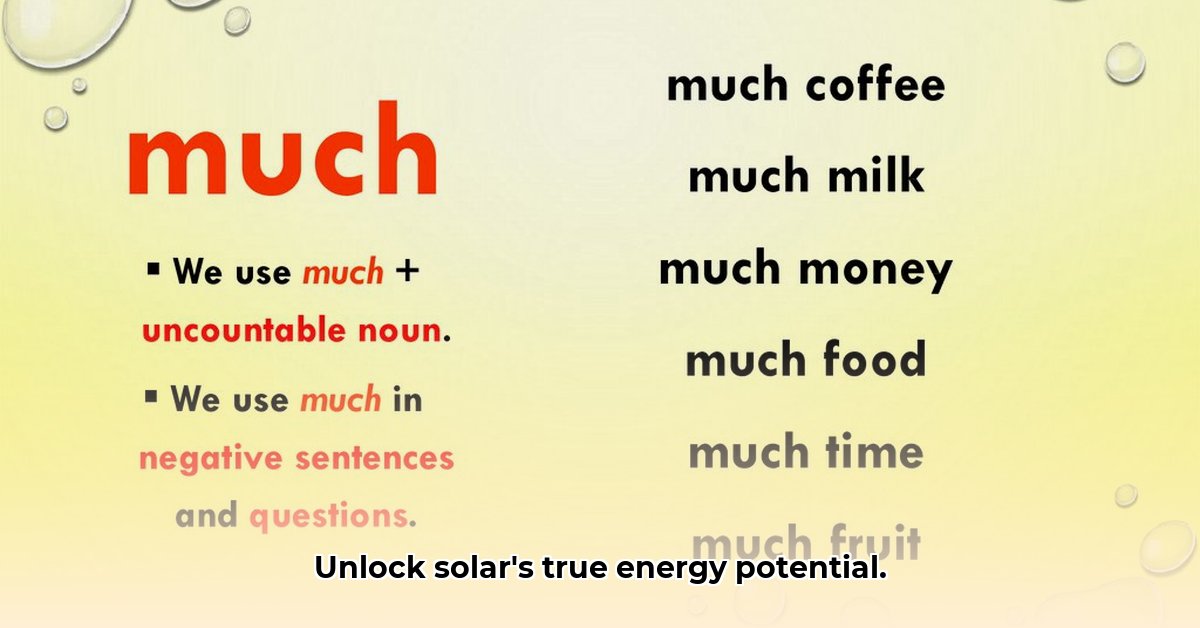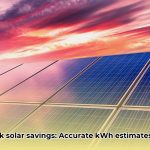Want to go solar but unsure how much power you’ll actually get? It’s not as straightforward as you might think! A lot goes into figuring out your solar panel’s energy output. Factors such as the type of panel, sunlight availability, geographical location and even roof orientation all play a part. This guide will break it all down, helping you understand what affects your solar panel’s energy production, compare different types of panels, and estimate your own energy needs. We’ll give you practical tips for getting the most from your solar system, ensuring your investment pays off for years to come. Let’s make solar power easy to understand! For a deeper dive into solar energy types, check out this helpful resource on solar energy types.
Understanding Solar Panel Energy Production
So, you’re thinking about solar power? That’s great! One of the most common questions is: how much electricity will those panels generate? The answer isn’t a simple “this many kilowatts.” It’s more like asking how fast a car can go – it depends on the car, the road conditions, and how hard you press the accelerator! Let’s examine the factors influencing your solar panels’ energy production and determine the factors that affect your solar system output.
Sunlight: Your Primary Power Source
The most significant factor in solar power generation is the sun itself. More sunshine directly translates to more electricity. This makes your geographical location crucial. For instance, if you live in a sunny state like Arizona, you’ll generate considerably more energy than someone in a cloudier city like Seattle. The yearly energy yield will vary drastically depending on the geographical influences on solar power.
Peak sun hours are a key concept here. These hours measure the time each day when sunlight intensity reaches at least 1,000 watts per square meter. This isn’t merely the number of daylight hours, but the period when the sun’s intensity is strong enough to maximize panel output.
Panel Power: Watts and Kilowatt-Hours Explained
Solar panels are rated in watts (W), indicating their power output under ideal conditions – think bright sunshine, cool temperatures, and a new panel. A typical residential panel might be rated between 300-450W. However, this is an instantaneous measurement. The amount of energy produced over time is measured in kilowatt-hours (kWh). A 400W panel in a location with 5 peak sun hours can generate approximately 2 kWh per day. This highlights the importance of understanding solar panel efficiency metrics for informed decisions.
Solar Panel Types: Making an Informed Choice
Solar panels use different technologies; the primary types are monocrystalline, polycrystalline, and thin-film. Monocrystalline panels are generally the most efficient, converting more sunlight into electricity. They also tend to be more expensive. Polycrystalline panels offer a more budget-friendly alternative but are slightly less efficient. Thin-film panels are lightweight and flexible, making them suitable for specific applications, but they’re typically the least efficient. The ideal type depends on your budget and unique requirements. Therefore, selecting appropriate solar panel technologies that fit your specific demands is crucial.
- Monocrystalline: Highest efficiency (20% and up), longer lifespan, most expensive.
- Polycrystalline: Moderate efficiency (15% to 17%), shorter lifespan than monocrystalline, more affordable.
- Thin-Film: Least efficient, shortest lifespan, most affordable, flexible applications.
System Size and Installation: Maximizing Efficiency
The total energy you generate depends on the number of panels you install and how they’re arranged. In the Northern Hemisphere, a south-facing roof is optimal for capturing the most sunlight. Obstructions like trees, buildings, or even your neighbor’s house can cast shadows that reduce the amount of electricity produced. Proper installation by a qualified professional is crucial to ensure that the system is set up to capture as much energy as possible. Correctly designing a residential solar energy system is crucial for maximizing energy capture.
Estimating Your Energy Needs: Tailoring the System
Before investing, calculate how much electricity you use. Your electricity bill is the best resource for this information. Proper domestic energy consumption patterns must be considered to determine system power. This calculation will help you and the solar installer determine the appropriate system size. Oversizing can be wasteful, while undersizing won’t meet your energy needs.
Factors Affecting Solar Panel Output: A Summary
The table below summarizes the key factors influencing how much energy your solar panels will produce:
| Factor | Impact on Energy Production |
|---|---|
| Sunlight Availability | The more sun, the more energy. Measured in peak sun hours (PSH). |
| Panel Wattage | Higher wattage panels generally produce more energy under ideal conditions. |
| Panel Efficiency | The type of panel significantly impacts total energy generation due to varying efficiencies. Monocrystalline is generally the most efficient. |
| System Size (Number of Panels) | More panels mean more energy, but proper sizing is key to matching your energy needs and roof space. |
| Roof Orientation & Shading | South-facing roofs (in the Northern Hemisphere) with minimal shading receive the most sunlight and therefore maximize energy production. |
| Panel Age & Degradation | Solar panels degrade over time, losing a small percentage of their efficiency each year (typically around 0.5%). |
| Weather Conditions | Cloud cover, rain, and snow all reduce energy production. Extreme temperatures can also affect efficiency. |
| Inverter Efficiency | The inverter converts DC power from the panels to AC power for your home. Its efficiency is a key factor in overall system performance. |
| Panel Angle & Tilt | The angle at which panels are mounted affects sun exposure. Adjusting the angle seasonally helps maximize energy capture. |
| Maintenance | Dirt, dust, and debris can block sunlight. Regular cleaning helps maintain optimal performance. |
Step-by-Step Guide to Going Solar
Follow these steps to launch your home solar project:
- Analyze Your Energy Consumption: Examine your electricity bills to understand your average monthly and annual energy usage in kilowatt-hours (kWh).
- Assess Your Roof: Evaluate your roof’s orientation (ideally south-facing), shading, angle, and overall condition.
- Obtain Multiple Quotes: Contact several reputable solar installers for detailed proposals.
- Compare System Designs: Carefully review the proposed systems. Pay attention to component quality, warranties, and the overall value.
- Explore Financing Options: Examine different loan, lease, and purchase options to identify the best solution for your budget.
- Monitor System Performance: After installation, actively monitor your system’s energy production to ensure it is performing as expected. Most systems feature online monitoring tools.
How much energy your solar panels will produce is unique to your situation. There is no one-size-fits-all answer. Research, consult with professionals, and you’ll be well on your way to harnessing the power of the sun!
Accurately Estimating Residential Solar Panel Energy Production
Key Takeaways:
- Solar panel energy output depends on a multitude of factors. Understanding them helps you develop realistic expectations and properly size your system.
- Panel wattage, location (sunlight), system efficiency, shading, and weather patterns all influence energy production.
- Online calculators offer preliminary ballpark estimates, while a professional assessment provides greater accuracy.
- Strategic panel selection and optimal location maximize energy production.
Understanding the Variables: Peak Sun Hours
Knowing how much power your solar panels will generate involves more than just looking at the wattage. Wattage represents the potential, while sunlight serves as the fuel. The amount of sunlight your location receives directly impacts your system’s kWh output. This is measured in peak sun hours (PSH). A higher PSH value means more available energy. The impact of sunlight on solar panel efficiency is crucial for accurate estimates.
Your home’s orientation and any shading issues also play a significant role. In the Northern Hemisphere, south-facing roofs receive the most sunlight throughout the day. Trees and buildings casting shadows can significantly reduce energy output.
Panel Efficiency: Panel Type
Different solar panel types offer varying levels of efficiency. Monocrystalline panels generally boast higher efficiencies than polycrystalline or thin-film alternatives. This is like comparing a high-mileage hybrid to a standard gasoline vehicle. Choosing the right solar panel material science impact directly affects your return on investment.
System Efficiency: Factoring in Real-World Losses
Solar panel systems are never 100% efficient. Energy losses occur due to wiring resistance, inverter inefficiency (DC to AC power conversion), and other factors. These losses, typically ranging from 15% to 25%, must be accounted for in your energy production estimates. It’s essential to think about system efficiency considerations in solar power.
Estimating Solar Potential: A Step-by-Step Calculation
Accurately estimating your solar panel’s energy production requires a careful, step-by-step approach:
- Determine Your Energy Needs: Calculate your household’s average daily energy consumption in kWh. Your electricity bill is the best source for this data.
- Determine Peak Sun Hours (PSH): Use online tools to find PSH data for your specific location. These tools typically require your latitude and longitude.
- Hydro Extrusions USA Leads North American Aluminum Profile Solutions - December 28, 2025
- Hydro North America Leads Aluminum Extrusion Solutions Across Diverse Industries - December 27, 2025
- Hydro Extrusion North America Provides Custom Solutions Across Diverse - December 26, 2025















